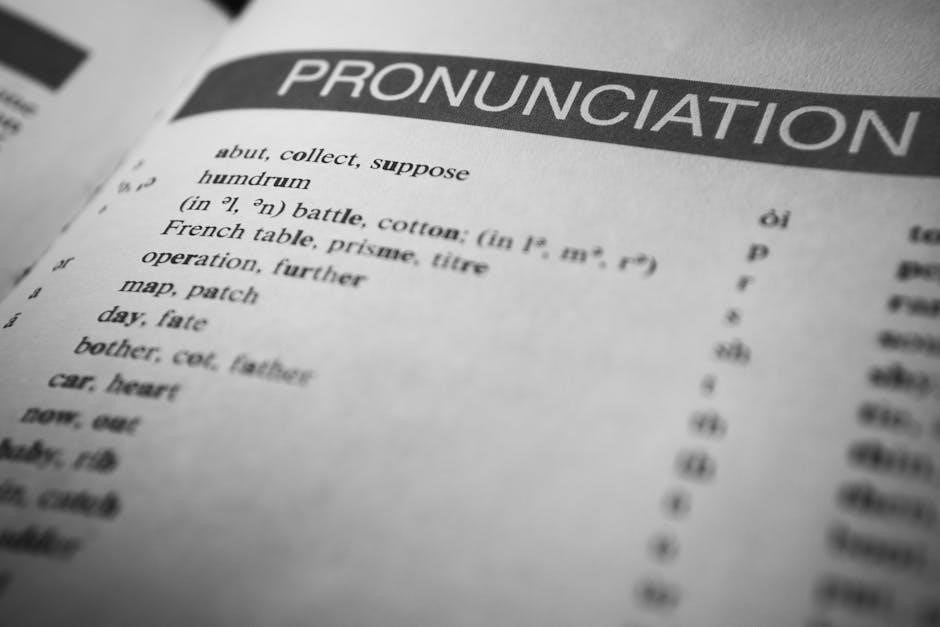
study guide romeo and juliet act 1
Study Guide: Romeo and Juliet Act 1
Dive into the tragic beginnings of Shakespeare’s masterpiece. Explore the escalating feud, Romeo’s infatuation, and the fateful encounter between the star-crossed lovers. Analyze key scenes, themes, and literary devices that set the stage for the play’s dramatic unfold.

Act 1 of Romeo and Juliet sets the stage for the tragic events that unfold in Verona. The play opens with a prologue that introduces the feud between the Montagues and Capulets, highlighting the destructive nature of their rivalry. This act establishes the central conflict and introduces key characters, such as Prince Escalus, who attempts to restore order, and the servants Sampson and Gregory, whose brawl escalates tensions. The prologue also introduces the concept of “star-cross’d lovers,” foreshadowing the doomed fate of Romeo and Juliet.
The act transitions to Lord and Lady Capulet’s discussion of Juliet’s potential marriage to Paris, revealing their societal expectations and Juliet’s youthful resistance. Meanwhile, Romeo’s infatuation with Rosaline is contrasted with his later encounter with Juliet, showcasing his emotional volatility. The introduction of the Nurse adds depth to Juliet’s character, as her loyalty and influence are highlighted. By the end of Act 1, the seeds of conflict and love are sown, preparing the audience for the tragic developments in subsequent acts.


The Prologue: Understanding the Setup
The prologue of Romeo and Juliet serves as a concise introduction to the play’s central themes and conflicts. Narrated by the Chorus, it outlines the setting in Verona and introduces the feud between the Montagues and Capulets. The use of the term “star-cross’d lovers” establishes Romeo and Juliet as victims of fate, whose love is doomed from the start. This setup immediately engages the audience, providing context for the events that will unfold.
The prologue’s language, rich in imagery and foreshadowing, sets a somber tone. It highlights the destructive nature of the families’ rivalry and the tragic consequences of their hatred. By summarizing the play’s outcome, the prologue creates a sense of inevitability, drawing the audience into the emotional journey of the characters. This opening effectively prepares viewers for the exploration of love, conflict, and fate that defines the play.
Scene 1: The Opening Fight and Its Significance
Scene 1 of Romeo and Juliet opens with a violent confrontation between servants of the Montague and Capulet families in a public square. This brawl immediately introduces the central conflict of the play: the bitter feud between the two families. The fight is interrupted by Prince Escalus, who condemns the violence and warns both families to end their rivalry. This scene establishes Verona as a city plagued by civil unrest and highlights the deep-seated hatred between the Montagues and Capulets.

The servants, Sampson and Gregory, reveal their loyalty to the Capulets and their disdain for the Montagues, showcasing the widespread animosity. Lord Capulet later reinforces this animosity when he demands justice for the brawl, further escalating tensions. The scene sets the tone for the play, emphasizing the destructive nature of the feud and its impact on the characters’ lives. It also introduces the theme of societal conflict and the futility of ongoing rivalry. This opening conflict foreshadows the tragic events that will unfold as the story progresses.
Characters Introduced in Scene 1: Sampson, Gregory, and the Servants
In Scene 1 of Romeo and Juliet, Shakespeare introduces Sampson and Gregory, two servants of the Capulet family, who are central to the opening conflict. Sampson is portrayed as bold and confrontational, openly expressing his hatred for the Montagues. Gregory, while equally loyal to the Capulets, appears more cautious, attempting to restrain Sampson’s aggression. Their banter reveals the deep-seated animosity between the two families and sets the tone for the play’s themes of rivalry and violence.
The servants’ dialogue also highlights their pride in serving the Capulets and their desire to defend the family’s honor. Their interaction with the Montague servants, Abram and Balthasar, escalates tensions, leading to the brawl that dominates the scene. These characters serve as catalysts for the feud, showcasing how even the lower classes are entangled in the families’ hatred. Their actions emphasize the pervasive nature of the conflict and its impact on all levels of Veronese society, setting the stage for the tragic events that follow.
The Role of Prince Escalus in Restoring Order

Prince Escalus, the ruler of Verona, plays a crucial role in Act 1 by intervening in the brawl between the Montagues and Capulets. His authority is established as he arrives on the scene, commanding respect and demanding an end to the violence. Escalus is portrayed as a fair but firm leader, weary of the ongoing feud. He scolds both families, warning them of severe consequences if the conflict continues.
Escalaus’s speech underscores the destructive nature of the rivalry and the need for peace. His presence serves as a temporary resolution to the chaos, restoring order in the public square. However, his inability to fully quell the feud highlights the deep-rooted hatred that persists beyond his control. This scene establishes Escalus as a voice of reason, yet it also foreshadows the eventual tragic outcome, as the families’ animosity proves resistant to his authority. His role in Act 1 sets the stage for the escalating tensions that drive the play’s narrative.
Scene 2: Lord and Lady Capulet’s Desires for Juliet’s Marriage
In Scene 2, Lord and Lady Capulet discuss their plans for Juliet’s marriage, revealing their societal ambitions. Lord Capulet, a pragmatic and authoritative figure, seeks to secure Juliet’s future through a advantageous alliance with Paris, a wealthy and well-connected suitor. Lady Capulet, though less assertive, supports her husband’s decision, emphasizing the importance of maintaining family honor and social standing. Both parents view Juliet as a commodity to strengthen their family’s position rather than as an individual with her own desires. Juliet, only 13 years old, is expected to comply without question, reflecting the patriarchal norms of Verona. The Nurse, who has cared for Juliet since childhood, offers a contrasting perspective, expressing affection and concern for Juliet’s well-being. This scene highlights the societal pressures on women and the lack of agency they held in matters of marriage, setting the stage for Juliet’s eventual defiance. The Capulets’ focus on material gain and status underscores the tension between family duty and personal desire.
Contrasting Perspectives: Lord Capulet vs. Lady Capulet
Lord and Lady Capulet exhibit contrasting approaches to Juliet’s future in Act 1. Lord Capulet is assertive and pragmatic, prioritizing family honor and social status. He insists on Juliet marrying Paris, viewing it as a strategic alliance to elevate their family’s standing. Lady Capulet, while supportive of her husband, shows a more nurturing side, expressing concern for Juliet’s youth and emotional readiness for marriage. Her approach is less rigid, reflecting a maternal desire for Juliet’s happiness. This contrast highlights the societal dynamics of Verona, where men held authority while women navigated their roles within these constraints. Lord Capulet’s authoritarian stance underscores the patriarchal norms, while Lady Capulet’s softer demeanor provides a glimpse of empathy. Their differing perspectives create tension, influencing Juliet’s growing determination to assert her own desires. This dynamic sets the stage for Juliet’s eventual defiance, as she struggles against the societal expectations imposed by her parents. Their contrasting views also foreshadow the familial conflict that will unfold.
The Nurse’s Influence on Juliet in Scene 3
In Scene 3 of Act 1, the Nurse plays a pivotal role in shaping Juliet’s perspective. As a trusted figure, the Nurse shares personal anecdotes, revealing her deep affection for Juliet and her late daughter, Susan. Her stories emphasize the importance of love and motherhood, creating an emotional bond with Juliet. The Nurse’s pragmatic approach to marriage, advocating for a wealthy match, contrasts with Juliet’s romantic ideals. This tension reflects the societal expectations placed on women, as the Nurse aligns with Lord and Lady Capulet’s wishes. However, her affection for Juliet also makes her a confidante, offering Juliet a space to express her feelings. The Nurse’s influence is dual-edged: while she supports the family’s goals, her personal connection to Juliet fosters a sense of trust that later becomes crucial in Juliet’s decisions. This dynamic underscores the Nurse’s complex role as both a guardian of tradition and a source of emotional support, highlighting her significance in Juliet’s journey.
Scene 4: The Capulet’s Party and Romeo’s Decision to Attend
Scene 4 of Act 1 takes place at the Capulet’s grand party, where Lord and Lady Capulet intend to introduce Juliet to Paris, her potential suitor. The atmosphere is lively, filled with music, dancing, and celebration. Romeo, still smitten with Rosaline, decides to attend the party despite the danger, as he hopes to catch a glimpse of her. This impulsive decision highlights Romeo’s emotional volatility and his tendency to act on passion rather than reason. Upon arriving, Romeo is immediately struck by Juliet’s beauty, and his infatuation with Rosaline fades. This moment marks a turning point, as Romeo becomes determined to meet Juliet, setting the stage for their iconic encounter. The party serves as a backdrop for the escalating tension between the Montagues and Capulets, as Tybalt recognizes Romeo and vows to confront him. Romeo’s decision to attend the party underscores the theme of fate and the inevitability of the tragic events that follow.
The Theme of Love vs. Infatuation in Romeo’s Character

Romeo’s character in Act 1 embodies the theme of love vs. infatuation, showcasing his emotional volatility and romantic idealism. Initially, Romeo is deeply infatuated with Rosaline, expressing his sorrow through dramatic and poetic language. His love for her is all-consuming, yet it is unrequited and idealized, highlighting the distinction between genuine love and superficial attraction. When Romeo meets Juliet at the Capulet’s party, his feelings shift dramatically, revealing a more profound and authentic connection. This transition underscores Shakespeare’s exploration of love’s complexity, contrasting Romeo’s earlier infatuation with his newfound passion for Juliet. Romeo’s impulsive nature and tendency to idealize love contribute to the tragic trajectory of the play, as his emotions often override reason. This theme not only defines Romeo’s character but also sets the stage for the devastating consequences of his actions, driven by a mix of love, loyalty, and impulsive decisions.
Scene 5: The First Meeting of Romeo and Juliet
Scene 5 marks the pivotal moment when Romeo and Juliet first meet at the Capulet’s ball, igniting the central conflict of the play. Romeo, disguised as a Masker, enters the Capulet’s house despite the families’ feud, driven by his infatuation with Rosaline and curiosity. Upon seeing Juliet, he is immediately captivated by her beauty and grace, exclaiming, “Did my heart love till now? Forswear it, sight, / For I ne’er saw true beauty till this night.” Juliet, equally enchanted, engages in a poetic exchange with Romeo, their dialogue rich in imagery and metaphor. Their meeting is charged with romantic tension, yet overshadowed by the families’ animosity. The scene sets the stage for their secret relationship, highlighting the conflict between love and loyalty. Shakespeare’s use of language and dramatic structure emphasizes the transformative power of their encounter, propelling the narrative toward its tragic conclusion. This moment is crucial in understanding the characters’ motivations and the inevitable fate that awaits them.

The Symbolism of the Balcony in Juliet’s Soliloquy

The balcony in Juliet’s soliloquy is a potent symbol of isolation, hope, and the divide between private and public worlds. It serves as Juliet’s refuge, where she can express her innermost thoughts and desires, free from the constraints of her family’s expectations. Standing on the balcony, Juliet embodies the tension between confinement and liberation, as she longs for Romeo while being physically separated from him. The balcony also symbolizes the divide between the two feuding families, with Juliet standing on one side and Romeo below, representing the bridge between their worlds. Shakespeare uses the balcony to highlight Juliet’s vulnerability and romantic idealism, as she declares her love openly, unaware of Romeo’s presence. This moment underscores the tragedy of their situation, as the balcony becomes both a symbol of their connection and the obstacle that separates them. The imagery of light and darkness surrounding the balcony further emphasizes Juliet’s emotional state and the fleeting nature of their love.
The Escalating Feud Between Montagues and Capulets
The feud between the Montagues and Capulets is central to Act 1 of Romeo and Juliet, driving the play’s tension and conflict. The opening scene showcases a violent brawl between their servants, highlighting the deep-seated hatred and rivalry. This clash spills into the streets of Verona, disrupting public order and prompting Prince Escalus to intervene, warning both families to end their cycle of vengeance. The animosity escalates further when Romeo, a Montague, crashes a Capulet ball, sparking a forbidden connection with Juliet. The families’ mutual distrust and hostility create a volatile environment, making their children’s love impossible. Shakespeare uses the feud to explore themes of loyalty, revenge, and fate, setting the stage for the tragic events that unfold. The escalating conflict underscores the destructive nature of unresolved hatred and its impact on the characters’ lives and decisions.
The Role of Fate and Fortune in Act 1
Fate and fortune play a pivotal role in Act 1 of Romeo and Juliet, shaping the characters’ destinies and the play’s tragic trajectory. The prologue introduces the concept of “star-cross’d lovers,” suggesting that the characters’ fates are predetermined by celestial forces beyond their control. Romeo’s belief in fortune and his reliance on dreams, as seen in his invocation of Queen Mab, further emphasize the theme of fate. The Capulets’ decision to marry Juliet to Paris and Romeo’s uninvited attendance at their ball are events that align with the idea of a predetermined course of action. Shakespeare uses these elements to create a sense of inevitability, highlighting the helplessness of the characters against the forces of fate. The interplay between fortune and the characters’ choices sets the stage for the tragic events that will unfold, illustrating how their lives are influenced by factors they cannot control.

Literary Devices in Act 1: Oxymorons, Imagery, and Iambic Pentameter
Shakespeare employs a variety of literary devices in Act 1 of Romeo and Juliet to enhance the emotional depth and thematic complexity of the play. Oxymorons, such as “bitter sweet” and “loving hate,” are frequently used by Romeo to express his conflicting emotions, particularly his infatuation with Rosaline and his subsequent love for Juliet. These contradictions highlight the turmoil and intensity of Romeo’s feelings, setting the stage for his impulsive decisions. Imagery is another key device, with vivid descriptions of Verona, the feud, and the Capulet ball creating a rich sensory experience. For instance, the prologue describes Verona as “fair” and the families’ hatred as an “ancient grudge,” while Romeo’s comparison of Juliet to a “snowy dove” underscores her purity and beauty. Additionally, Shakespeare’s use of iambic pentameter gives the dialogue a rhythmic, poetic quality, emphasizing the emotional intensity of the characters’ interactions. These literary devices collectively immerse the audience in the world of the play and underscore its central themes of love, conflict, and fate.
Study Guide Questions and Analysis for Act 1
Engage deeply with Act 1 of Romeo and Juliet by exploring its key themes, characters, and literary elements. Consider the following questions to enhance your understanding:
- What is the significance of the prologue, and how does it set the tone for the play?
- How does Shakespeare portray the conflict between the Montagues and Capulets in Scene 1?
- Analyze Romeo’s character development in Act 1. How does his infatuation with Rosaline differ from his love for Juliet?
- What role does the Nurse play in Juliet’s life, and how does she influence Juliet’s decisions?
- Examine the theme of fate vs. free will. How does this theme emerge in Act 1?
These questions encourage critical thinking about the play’s structure, character motivations, and thematic undertones. Act 1 lays the foundation for the tragic events that unfold, introducing the central conflict and the star-crossed lovers whose fates are inextricably entwined. By analyzing these elements, readers can better appreciate Shakespeare’s masterful storytelling and the enduring relevance of his work.